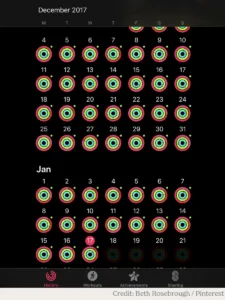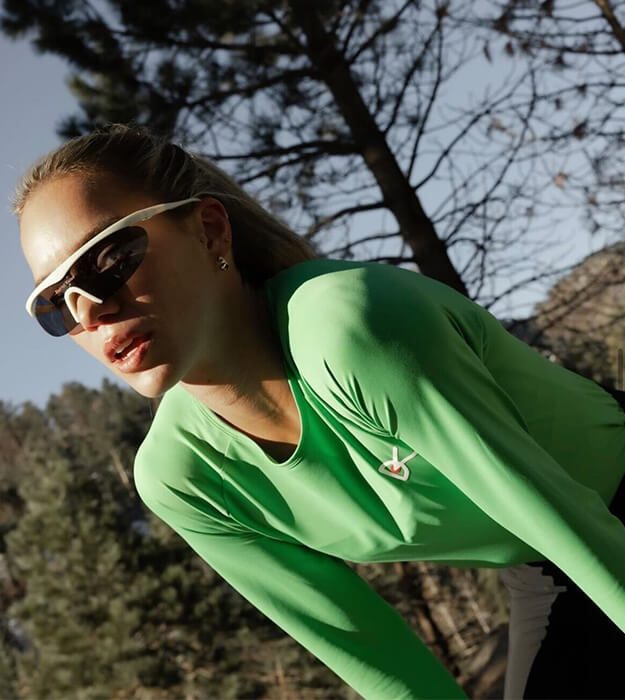Image Credit: @wlsgrace
Our editors independently select these products. Making a purchase through our links may earn PLEIN AIR a commission.
A few weeks ago, the concept of “beige flags” was everywhere across Reels, TikTok, and the general cultural consciousness. A beige flag, unlike a red or a green flag, is a weird or unusual quirk that doesn’t require judgment so much as a pause. While thinking over mine—using the same alarm clock song since 2014 and still listening to it normally (Budapest by George Ezra), needing the first sip of a beverage before I can share it with whoever’s asked—the most prevalent one in the course of my day-to-day life has got to be that, at any given time, I am wearing about four different fitness trackers. Fatal flaw: if I haven’t tracked it, my workout might as well not count. (I know it’s a toxic mindset, but it’s there.)
It started as most gentle addictions do. “I just wanted to try it,” or “it seemed so healthy at the time.” But the first step to getting help is admitting you have a problem so I’m Grace, and I’m a fitness tracker-aholic.
The benefits of a fitness tracker are tenfold, but the device you’ll want to use across the plethora available in the market depends on your most important value: sleep, athletic training, general wellness, or others. A fitness tracker is generally a wearable device, usually on your wrist although rings have become more popular too, that can track your steps, heart rate, recovery, and more throughout the day.
Why should you use a fitness tracker?
First, I used the fitness tracker to boost my motivation and hit my step count. It was a game between me and family, a small “yes!” with camp counselor friends when we “closed our rings” and hit our fitness goals. Then the data got more sophisticated, influencing everything from my bedtime to my itinerary for the day. I love fitness trackers for the following reasons, among many:
- I used to get sick all the time, but I know that if I get two poor sleep scores in a row—or my recovery suddenly drops—that I need to completely cancel all my plans, take a DayQuil, and sleep it off before it hits. Since then, I’ve been so much healthier and have rarely gotten colds, and I wouldn’t have had access to that data if not for a wearable that knows how my body feels before I do.
- I generally have a hard time not pushing myself (hence the perpetual illness), so I love that a fitness tracker will tell me the days I should take a break. Of course, I’ll still take an off day if I want to, but I love that it’ll answer the question for me when I’m deciding whether or not I should go to the gym after work.
- As a runner training for the New York City marathon this fall, I of course love having data to pull from to most effectively structure my training, as I am frankly terrified to run this 26.2 miles.
- I am a terrible sleeper, and experimenting with sleep data has allowed me to figure out and physically see which factors will tank my rest the most (for me: alcohol. If I even have one glass of wine, I’ll sleep terribly—so knowing that has made me want to drink less!)
Still, picking out the right fitness tracker—beyond the physical specs—is frankly overwhelming, which is why I’ve done the work for you and tested all the major players. Here’s my informal overview of what’s best for each type of mover.
The Fitness Trackers You Should Know About:
- Apple Watch—Best Fitness Tracker for Motivation and Goals, $249.
- Oura Ring—Best Fitness Tracker for Sleep, $299 & $5.99/month.
- Garmin Forerunner 245—Best Fitness Tracker for Runners, $279 (was $299).
- Whoop 4.0—Best Fitness Tracker Overall, But With Some Annoyances, $30/month.
Best Fitness Tracker for Motivation and Goals
Apple Watch—$249
The Apple Watch is the good ol’ OG, a jack of all trades pick that fits neatly within the iOS ecosystem many of us subscribe to. While many friends and family have told me their hangup with the Apple Watch is that they don’t like having all their notifications on their wrist too (the phone addiction is hard enough to shake), I actually find the reverse is true and it actually keeps me more unplugged. I generally have my app notifications turned off, which means I have a certain amount of freedom in leaving my phone in another room. If a text or call comes through—you know, the important things—I’ll find out via my watch and don’t have to keep my attention-box glued to my hip. So I love it for that.
Fitness-wise, the Apple Watch shines with its dopamine-boosting rings system. You can set your calorie (activity) goal, a workout goal (number of minutes you’ve been moving), and a stand-up goal. These show up as a three-ring home screen on your watch, and the goal is to fill them throughout your day. I find this system to be more motivating than any of the other interfaces, as gamifying your activity level has never been easier. For those who are reluctant movers or feel a little too immobile in the course of their WFH job, the Apple Watch is a great pick. It also has a wide variety of workout settings to try, which makes it convenient for wading into more consistent activity. For most people, the Apple Watch will do just fine. You do need to charge it every day, which is a reason many opt for other models.
Best Fitness Tracker for Sleep
Oura Ring—$299 & $5.99/month
If the sensation of having a watch or band on your wrist annoys you, consider a smart ring instead. The first breakthrough in this category is the Oura Ring, which claims that HRV (heart rate variability, and one of the most important data points that fitness trackers use) is significantly more accurate when measured through the finger rather than the wrist.
For years, friends have been telling me that I needed the Oura Ring because one of the most fundamental reasons I need a fitness tracker is to try to get my sleep under control. I love sleep, I prioritize it, I test sleep products frequently—but still, I have an episodic insomnia problem when I’m stressed, overwhelmed, or emotional. I just can’t turn my brain off during those high-intensity periods. It’s not constant and I’m still 100 percent a morning person, but it’s always hard when that week-long bout swings around and completely throws off my routine. So: sleep tracker, to correct before it gets bad. Supposedly, the Oura Ring is the best of the best when it comes to snoozes.
I’ve been using the Oura Ring for about a month, and don’t love the interface; I’m not entirely sure what data I’m reading, but I have to admit the sleep info is pretty damn thorough. Plus, the ring is unobtrusive—and even stylish—as part of my lineup. It doesn’t read workouts as accurately (and I worry about lifting weights while wearing it, as I always take off my rings to do so) but the fans are correct: Oura Ring is the one you’ll want to pick if you’re trying to improve your rest and recovery.
Like the Whoop 4.0, an Oura obviously doesn’t have a screen so will not give you live feedback during your workouts; instead, you’ll use the Oura for the rest, recovery, and post-mortem aspects of your movement. It does seem to lose battery at a decent level, so I charge perhaps every few days.
Best Fitness Tracker for Runners
Garmin Forerunner 245—$279 (was $299)
Ah, the Garmin. Peers say they know who’s a runner based on who’s wearing a Garmin. It feels vaguely culty, and extremely appealing to my personality type. While the Garmin system is tailored towards runners (ideally training for a race), you can use it for other activities as well and customize the data fields that it will track during your workouts—calories, lap pace, average pace, heart rate, elapsed time, etc,. I generally use it to run and to swim, and it’s my bread and butter nowadays for the most holistic overview of my body’s well-being.
The pro of the Garmin as opposed to, say, the Whoop 4.0 or the Oura, is that it’s a one-time cost. Once you buy the watch, you’re in forever—no need to cough up a monthly fee or lose access to your data. Personally, I appreciate the app’s interface, with a whole list of data points from the day, the previous day, and a summary box at the bottom with your past week. Of course, once you sync your watch to the app, you can reference data points from the past year. If you’re trying to lose weight or bulk muscle, the Garmin even has a connected scale that you can link up to the ecosystem to track those kinds of metrics.
For specific runs, the Garmin will tell you everything from your stride length to your average power, which is helpful in knowing how to tailor my strength training too. At the end of your workout, it’ll ask you how it felt and how you felt, and I generally use it as a running diary too to record the factors that may have influenced my performance — “today, I didn’t want to go but I felt great once out there— I started to cramp because I didn’t drink enough water” — etc,. etc,. Overall, it’s a powerhouse of data helpful to those training. The watch will last approximately a week without needing to charge.
Best Fitness Tracker Overall, But With Some Annoyances
Whoop 4.0—$30/month
The Whoop 4.0 is the vaguely toxic ex you go back to despite knowing they’re never going to change. Still, tragically, there’s a reason for this particular relapse: it’s just the best all-around. Personally, I love the Whoop 4.0 interface the most. It seems to track my sleep extremely accurately, gives me that ring-based motivation of the Apple Watch (in which you try to match up your strain level to your recovery score), a helpful overview of recovery and when you should slow down, and helpful weekly and monthly summaries of your training. It’s extremely helpful in starting to train vs. starting to move. The band itself is simple to wear, and unlike the others, you can charge it during use—you slip a portable charger over the top and can wear it during your workout, which is incredible. There’s little I hate more than gearing up to exercise and realizing my tracker’s dead. Unlike the others, you will not get live feedback during your workout, as it’s like a bracelet rather than a watch.
Still, the reason you break it off every time with the Whoop 4.0 (“I swear things are going to be different this time”) is that it forces you to lock into its subscription model or you lose all your data forever. Frankly, Whoop as a company can do whatever it wants and you put up with it. Anecdotally, I find the CEO’s claims about the device’s capabilities and health benefits to sound exaggerated and overreaching which also makes me hesitant to spend my money here, but readers can draw their own conclusions. I’ve quit the Whoop 4.0 and come back multiple times, and I’m still mixed on it, although its data and interface is my favorite of the bunch.
But the data’s awesome. It feels sophisticated, is extremely motivating, and also seems balanced in giving you athletic versus recovery information. It’s very easy to see what you need to do to get to the next level of your fitness, and is the perfect device for those who are starting to get serious about what exercise can do for them. There’s a daily questionnaire you can use that will analyze your habits and see what’s affecting each aspect of your health—i.e. you drank on this day and slept terribly, or you journaled on this day and enjoyed reduced stress. It makes it very easy to be healthier and get that tangible, immediate positive feedback scientifically proven to solidify a habit. It spoon-feeds you, which many love. If you’re working towards a milestone or significant change, the Whoop 4.0 is probably what you want.

































Leave a comment
This site is protected by reCAPTCHA and the Google Privacy Policy and Terms of Service apply.